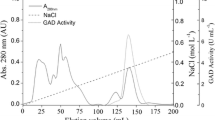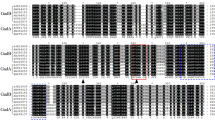Abstract
Cell-free extracts of proteolytic strains of Clostridium botulinum types A, B and F (group I) were found to have unusually high specific activities of NAD+-dependent L-glutamate dehydrogenase (NAD-GDH). In comparison, nonproteolytic strains of types B, E and F (group II) had low specific activities. The enzyme was purified 131-fold from C. botulinum 113B to a final specific activity of >1,092 μmolxmin-1xmg protein-1. The enzyme is a hexamer of a polypeptide of Mr=42,500, and the native molecular weight is 250,800. The apparent K m values for substrates were 5.3 mM for glutamate and 0.028 mM for NAD+ in the deamination reaction, and 7.2 mM for α-ketoglutarate, 243 mM for NH +4 and 0.028 mM for NADH in the reverse reaction. NADP+ did not serve as a hydrogen acceptor for the enzyme. Activity in the animation direction was inhibited by fumarate, oxalacetate, aspartate, glutamate and glutamine. The results suggest that GDH is important in group I (proteolytic) C. botulinum to generate α-ketoglutarate as a substrate for transamination reactions. We have also found that the high activity decreases significantly when cells are exposed to sodium chloride. Therefore GDH probably has several important physiological roles in group I proteolytic C. botulinum.
Similar content being viewed by others
References
Bader J, Rauschenbach P, Simon H (1982) On a hitherto unknown fermentation path of several amino acids by proteolytic clostridia. FEBS Lett 140:67–72
Barker HA (1981) Amino acid degradation by anaerobic bacteria. Ann Rev Biochem 50:23–40
Bradford M (1976) A rapid and sensitive method for the quantification of microgram quantities of protein utilizing the principle of protein-dye binding. Anal Biochem 72:248–254
Braunstein AE (1939) The enzyme system of trans-amination, its mode of action and biological significance. Nature 143:609–610
Buckel W, Barker HA (1974) Two pathways of glutamate fermentation by anaerobic bacteria. J Bacteriol 117:1248–1260
Cato EP, George WL, Finegold SM (1986) Genus clostridium. In: Sneath PHA, Mair NS, Sharpe ME, Holt JG (eds) Bergey's manual of systematic bacteriol, vol 2. Williams and Wilkins, Baltimore, MD, pp 1141–1200
Clarke B, Allendorf FW (1979) Frequency-dependent selection due to kinetic differences between allozymes. Nature 279:732–734
Davis BJ (1964) Disc electrophoresis. II. Method and application to human serum proteins. Ann NY Acad Sci 121:404–427
Darlow HM (1969) Safety in the microbiological laboratory. In: Norris JR, Ribbons RW (eds) Methods in microbiology. Academic Press, New York, pp 169–204
Elsden SR, Hilton MG (1979) Amino acid utilization patterns in clostridial taxonomy. Arch Microbiol 123:137–141
Goldfine H, Stadtman ER (1960) Propionic acid metabolism. V. The conversion of β-alanine to propionic acid by cell-free extracts of Clostridium propionicum. J Biol Chem 235:2238–2245
Goldin B, Frieden C (1971) Glutamate dehydrogenases. Curr Top Cell Reg 4:77–117
Hardman JK, Stadtman TC (1963) Metabolism of ω-amino acids. III. Mechanism of conversion of γ-aminobutyrate to γ-hydroxybutyrate by Clostridium aminobutyricum. J Biol Chem 238:2081–2087
Kihm DJ, Hutton MT, Hanlin JH, Johnson EA (1988) Zinc stimulates sporulation in Clostridium botulinum 113B. Curr Microbiol 17:193–198
Laemmli UK (1970) Cleavage of structural proteins during the assembly of the head of bacteriophage T4. Nature (Lond) 227:681–685
Lynt RK, Kautter DA, Solomon HM (1982) Differences and similarities among proteolytic and nonproteolytic strains of Clostridium botulinum types A, B, E and F: a review. J Food Prot 45:466–474
Mead GC (1971) The amino acid-fermenting clostridia. J Gen Microbiol 67:47–56
O'Neil SR, DeMoss RD (1968) Tryptophan transaminase from Clostridium sporogenes. Arch Biochem Biophys 127:361–369
Shaw CR, Prasad R (1970) Starch gel electrophoresis of enzymes —a compilation of recipes. Biochem Gen 4:297–320
Smith EL, Austen BM, Blumenthal KM, Nye JF (1975) Glutamate dehydrogenases. In: Boyer PD (ed) The enzymes, vol 11, 3rd edn. Academic Press, New York, pp 293–367
Smith LD (1977) Botulism: the organism, its toxins, the disease. Charles C Thomas, Springfield, IL
Smith LD, Williams BL (1984) Clostridium botulinum. In: Pathogenic anaerobic bacteria, 3rd edn. Charles C Thomas. Springfield, IL, pp 148–163
Whitmer ME, Johnson EA (1988) Development of improved defined media for Clostridium botulinum serotypes A, B and E. Appl Environ Microbiol 54:753–759
Winnacker EL, Barker HA (1970) Purification and properties of a NAD-dependent glutamate dehydrogenase from Clostridium SB4. Biochim Biophys Acta 212:225–242
Author information
Authors and Affiliations
Rights and permissions
About this article
Cite this article
Hammer, B.A., Johnson, E.A. Purification, properties, and metabolic roles of NAD+-glutamate dehydrogenase in Clostridium botulinum 113B. Arch. Microbiol. 150, 460–464 (1988). https://doi.org/10.1007/BF00422287
Received:
Accepted:
Issue Date:
DOI: https://doi.org/10.1007/BF00422287




